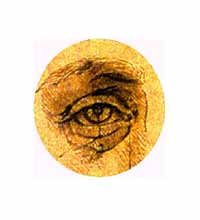THE ENIGMA OF LUCA PACIOLI'S PORTRAIT
“ IACO. BAR. VIGENNIS P.1495 ”
“CARTIGLIO” SIGNATURE AND FLY
Is it just for a lack of documentations, witnesses
and historical attestations, if the attributive question of the
enigmatic “Luca Pacioli’s Portrait” ( Gallery of Museum of Capodimonte,
Naples) – depicting Luca Pacioli, the friar and Mathemathic Author of
“Summa de Arithmetica” and of the “Divina Proportione”- is still
unsolved?
The available documentations doesn’t give any specifical information
about the execution or the original assignment of the Portrait.
The first documental information are from a century later of the
presumable execution of the Portrait, and they dated back to a 1631’s
inventory, however without any explanation about the date and the way
of accession in Urbino, at Palazzo Ducale.
The Portrait was included in a list of goods of Della Rovere’s dinasty.
This first inventory reports just mere hypotesis and even the sudden
documentations stopped just reporting the movements of the Portrait,
during the half of the XVII century, from Urbino to Florence and from
the Urbino’s dinasty to the Medici dynasty, by Vittoria della
Rovere-Medici.
Traces of the Portrait appear again in the later centuries in Naples,
still in Medici’s belongings, collateral branch of Ottaviano. These
traces will then take to its actual musuem position after the state
pre-emption against the foreign selling of the Portrait.
The historical tradition is silent about the actual and generic
attribution (based on a signature), is referred to uncertain
interpretations on the acronym indication relieved from the anomal
“cartiglio” presented in the Portrait.
The historical and critical research haven’t yet found an incentive
either progress, even though there have been critics on the original
past given hypotesis.
After an initial solicitation due to the acquisition of the Portrait by
musuem of Capodimonte, despite other periodical examinations, the
solution of the question is still at the same point without any new
substantial or critically resolutive documentations. There haven’t been
either different indications on new elements about the Pacioli’s
Portrait, for opening again other ways of processing investigations.
The attributive research is at a stop, after the progressive exhaution
of possible interpretations detectable from the picture’s clues.
Considering the elevated pictorial and artistic quality of the
Portrait, the intensification in exposing the picture, the deep spread
of the image through photos – even as icon on editorial work’s covers,
the lack of recent studies assumes a characterisation and a meaning of
a proper real implicite disistance on the investigations.
The obstacle for the researches is found in the misleading abbreviation
and inscription: "IACO.BAR. VIGENNIS. P. 1495", apparent marking and
ineludibile and unsolved cryptography, made still more ambiguous by the
representation of a fly.
The interpretation of the misunderstood “cartiglio” and its
inscriptions and abbreviations, influenced the research of the Portrait
from the beginning, taking on a different way the perspectives and the
historical directions in order to find the author of the work.
Either the omission of a deepened hermeneutic of the painting and the
preference given to the only stylistic analysis, had clasped the
research field neglecting other needed ways of critical investigation.
The question has been then left to an occasional solution, to a mere
and eventual archivistical solving, that hasn’t been reached yet.
Based on this anomaly, even caused by the absence of historical
quotations and tradition, had also influenced the reductive effect by
the anonymous and reserved maintenance at the Urbino Palazzo Ducale and
the next following owners of the Portrait.
The portrait has been considered for its documentary and historical
value rather than its artistic importance. This judgment is not
adequated considering the contents and the aestethical qualities
expressed in the picture.
The work, even though substantially misunderstood, has reached prestige
and fame, even without a clamour of a fair paternity.
INCREASE AND OBSERVE
GEOMETRY AND PROPORTION

|

|
COMPARISON OF ALFABETIC TYPES

|

|

|
PROPORTION AND PROPORTIONALITY

|

|
|||
|
|
|
PORTRAIT COMPARISON

|

|
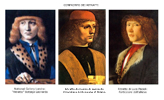
|
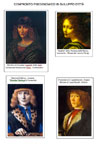
|
|
|
® Ideas, texts, graphic elaboration have been edited for a research and study, diffusion and promotion of the critical question. The copy and reproduction is strictly forbidden and reserved. The copyrights of the works named in this website are reserved to the Body Corporate and Museum according to the law. ©
CRITICAL CONFRONTATIONS
CERTIFICATION OF LUCA PACIOLI ON COLLABORATION AND PERSPECTIVE DESIGNS OF THE LEONARDO POLYHEDRA ANNEXES TO THE TEXT “DE DIVINE PROPORTIONE”
In his "Epistle" introductory to the "De Viribus Quantitatis" the monk mathematical Luca Pacioli makes explicit recognition to Leonardo da Vinci for the collaboration and native conception and valuable execution in "prospectivo sketch", that is in perspective effect and also three-dimensional stereometrico, of the poliedris of the "De Divine Proportione" (cfr.: "De Viribus Quantitatis" edition Corporate body Picked Vinciana, Milan MCMXCVII, text with Maria's Garlaschi Peirani transcript drawn by the code n. 250 of the University Library in Bologna and with preface and direction of Augusto Marinoni)
“Et non manco ancora in la sublime altra nostra opera detta “Della Divina Proportione” nelli anni similmente salutiferi 1496 a lo excellentissimo et potentissimo duca di Milano, Ludoviarico Ma Sforza S.F. dicata et con dignissima gratitudine praesentata, ne fo discorso con le supraeme et legiadrissime figure de tutti li platonici et mathematici corpi regulare et dependenti, che in prospectivo disegno non č possibile al mondo farle meglio, quando bene Apelle, Mirone, Policreto e gli altri fra noi tornassero, facte et formate per quella ineffabile senistra mano a tutte le discipline acomodatissima del prencipe oggi fra mortali pro prima fiorentino, Lionardo nostro da Venci, in quel foelici tempo che insiemi a medesimi stypendii nella mirabilissima citą di Milano ci trovammo”
Nick Mackinnon, The Mathematical Gazette, n. 77, 1993, pag. 143
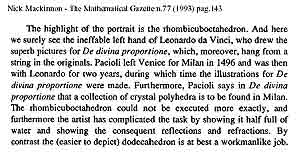 |
“The highlight of the portrait is the rhombicuboctahedron. And here we surely see the ineffable left hand of Leonardo da Vinci, who drew the superb picture for De divina proportione, which, moreover, hang from a string in the originals. Pacioli left Venice for Milan in 1496 and was then with Leonardo for two years, during which time the illustrations for De divina proportione were made. Furthermore, Pacioli says in De divina proportione that a collection of crystal polyhedra is to be found in Milan. The rhombicuboctahedron could not be executed more exactly, and furthermore the artist has complicated the task by showing it half full of water and showing the consequent reflections and refractions. By contrast the (easier to depict) dodecahedron is at best a workmanlike job.”
Geofroy Tory, “Champ Fleury”, 1529, Le Segond Livre, Feuil XIII
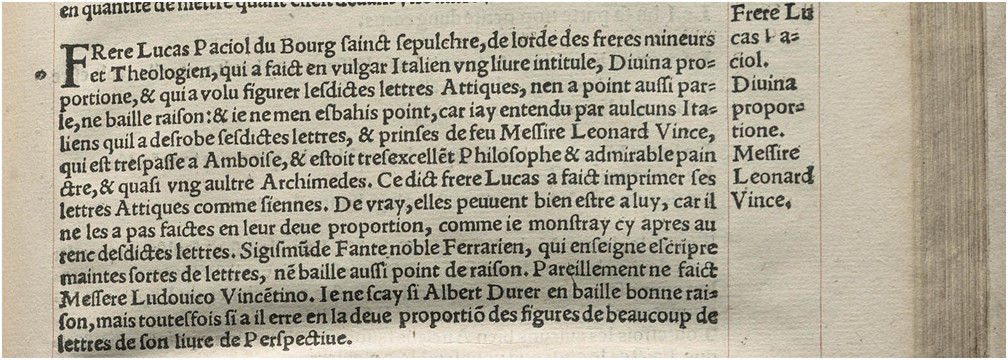
(treatise of "art and science of the due and true
proportion of the Attic letters,
otherwise named Ancient letters and vulgarly Roman letters,
proportionated according to the body and the human face")
« Frere Lucas Paciol du Bourg sanct sepulchre, de lorde des freres mineurs et Theologien, qui a faict en vulgar Italien vng livre intitule, Divina proportione, & qui a volu figurer le dictes lettres Attiques, nen a point aussi parle, ne baille raison: & ie ne men esbahis point, car iay entendu par aulcuns Italiens quil a desrobe ses dicte lettres, & prinses de feu Messire Leonarde Vince, qui est trespasse a Amboise, & estoit tres excellent Philosophe & admirable painctre, & quasi vng aultre Archimedes. Ce dicte frere Lucas a faict imprimer ses lettres Attiques comme sienne. »
“Fra’ Luca Pacioli from Borgo San Sepolcro, monk
of the order of the Grey Friars and theologian, who wrote in Italian
vernacular a book entitled “Divina proportione” and has intended to
represent the aforesaid Attic letters, did not describe them at all,
neither gave any explanation about; and I am not surprised at all about
this, because I’ve heard from some Italian people that he had taken the
letters away from the late Mr. Leonardo Vinci,who’s dead in Amboise and
was a very excellent philosopher and admirable painter and almost
another Archimedes. This told fra' Luca made print those letters as his
owns.”
CONFERENCE HELD IN NAPLES ON APRIL 2nd 2016
View the presentation (in Italian)
View the video (in Italian) of the event appeared on the television channel TV2000, the 15.4.2016
THE 500TH ANNIVERSARY CONFERENCE HELD IN NAPLES ON DECEMBER 3rd 2019
View
the poster
View
the presentation
(in Italian)
THE DARK ROOM OF LEONARDO
View the article (in Italian) published in the daily newspaper Rome, the 25th of may 2016
"IACO.BAR.VIGENNIS
P. 1495" TREATY
It contains a more extensive discussion on the "Portrait", on the collaboration between Leonardo and Pacioli, on related writings and reflections on aesthetics and philosophy. See the treaty (in Italian)
AESTHETIC, HISTORICAL, CRITICAL, TECHNICAL INVESTIGATIONS AND BUREAUCRACY
I)
Extract from the correspondence with professor Pietro C. Marani
component of the Ministerial Commission for the celebrations of the
fifth centenary of Leonardo 2019 (click here - documents in Italian)
(II)
Generic advice of the Pinacoteca of Capodimonte sent by the Ministry of
cultural heritage and related observations in replication (click here - documents in Italian)
(III)
Opinion of the management of the department of Prints and Drawings in
the Galleries of the Accademia of Venice, on the relationship between
Leonardo's drawing (Inventory 264) and the Portrait of Luca Pacioli (click here - documents in Italian)
COMMENTS AND CONTRIBUTIONS TO THE QUESTION
If you want to send an email to the author, please use the form on the page in Italian
| Email this website to promote the question, |
| to incentive further searches |
| and to valorize the Portrait |


